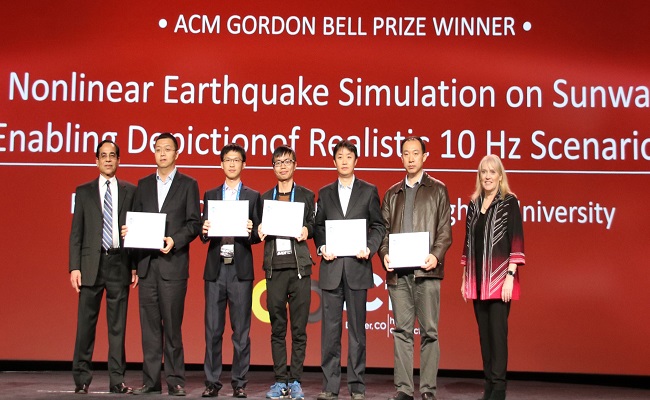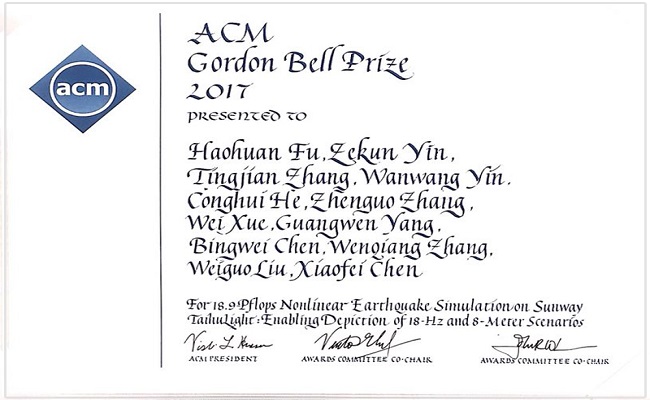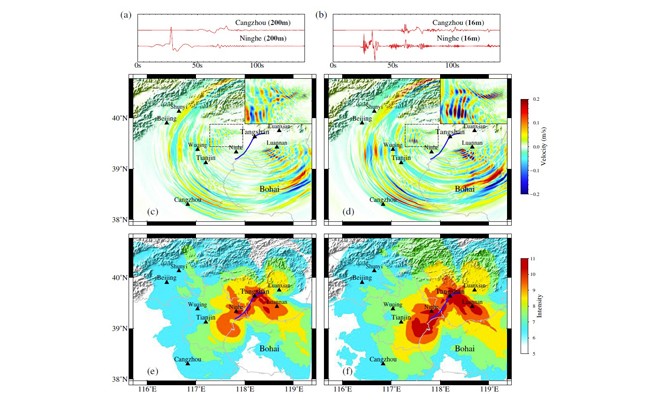2017 ACM Gordon Bell Prize awarded to Chinese team led by Tsinghua on Nonlinear Earthquake Simulation employing the world’s fastest supercomputer
ACM named a 12-member Chinese team, five of whom are from Tsinghua University, as the recipients of the 2017 ACM Gordon Bell Prize, for their research project, “18.9-Pflops Nonlinear Earthquake Simulation on Sunway TaihuLight: Enabling Depiction of 18-Hz and 8-Meter Scenarios.” Using the Sunway TaihuLight, which is ranked as the world’s fastest supercomputer, the team developed software that was able to efficiently process 18.9 Pflops (or 18.9 quadrillion calculations per second) of data and create 3D visualizations relating to a devastating earthquake that occurred in Tangshan, China, in 1976. This is the second time that the prize has been given to a Chinese research team.

The ACM Gordon Bell Prize tracks the progress of parallel computing and rewards innovation in applying high performance computing to challenges in science, engineering, and large- scale data analytics. The award was presented by ACM President Vicki Hanson and Subhash Saini, Chair of the 2017 Gordon Bell Prize Award Committee, during the International Conference for High Performance Computing, Networking, Storage and Analysis (SC17) in Denver, Colorado on Nov 17th, Beijing Time.

Although earthquake prediction and simulation is an inexact and emerging area of research, scientists hope that the use of supercomputers, which can process vast sets of data to address the myriad of variables at play in geologic events, may lead to better prediction and preparedness. For example, the Chinese team’s 3D simulations may inform engineering standards for buildings being developed in zones known to be prone to earthquakes. In this vein, many have advocated for a significant increase in the amount of sensors to regularly monitor seismic activities. The Tangshan earthquake, which occurred on July 28, 1976 in Tangshan, Hebei, China, is regarded as the most devastating earthquake of the 20th century. In developing their simulations for the Tangshan earthquake, the winning team included input data from the entire spatial area of the quake, a surface diameter of approximately 320 km, as well as 40 km deep below the Earth’s surface. The input data also included a frequency range of the earthquake of up to 18 Hz (Hertz). In the study of earthquakes, a Hertz is a unit of measurement that measures the number of times an event happens in the period of a second. For example, it might correspond to the number of times the ground shakes back and forth during an earthquake. Previous simulations of violent earthquakes have employed a lower frequency than 18 Hz, since enormous memory and time of computation are needed for high frequency simulations.

This year’s winning team is not the first to develop algorithms for supercomputers in an effort to simulate earthquake activity. In the abstract of their presentation, the 2017 Gordon Bell recipients write: “Our innovations include: (1) a customized parallelization scheme that employs the 10 million cores efficiently at both the process and thread levels; (2) an elaborate memory scheme that integrates on-chip halo exchange through register communication, optimized blocking configuration guided by an analytic model, and coalesced DMA access with array fusion; (3) on-the-fly compression that doubles the maximum problem size and further improves the performance by 24%."
Of its new innovations, the Chinese team adds that its on-the-fly compression scheme may be effectively applied to other challenges in exascale computing. In their paper, the authors state: “The even more exciting innovation is the on-the-fly compression scheme, which, at the cost of an acceptable level of accuracy lost, scales our simulation performance and capabilities even beyond the machine’s physical constraints. While the current compression scheme is largely customized for our specific application and the Sunway architecture, we believe the idea has great potential to be applied to other applications and other architectures.”
The first author of the paper is Haohuan Fu, Associate Professor in the Department of Earth System Science, Tsinghua University and the National Supercomputing Center, Wuxi, China. The co-corresponding authors include Haohuan Fu, Conghui He, and Wei Xue, from Tsinghua University and the National Supercomputing Center, and Xioafei Chen, from the Southern University of Science and Technology, China. Other authors include Bingwei Chen, Tsinghua University and the National Supercomputing Center; Zekun Yin, Shandong University; Zhenguo Zhang, Southern University of Science and Technology, China; Wenqiang Zhang, University of Science and Technology of China; Tingjian Zhang and Weiguo Liu, Shandong University; Wanwang Yin, the National Research Center of Parallel Computer Engineering and Technology, China; and Guangwen Yang, Tsinghua University and the National Supercomputing Center.
This research project was jointly completed by the Department of Earth System Science and the Department of Computer Science and Technology, Tsinghua University, together with Shandong University the Southern University of Science and Technology, the University of Science and Technology of China, the National Research Center of Parallel Computer Engineering and Technology, China, and the National Supercomputing Center, Wuxi, China.
Innovations from advanced scientific computing have a far-reaching impact in many areas of science and society—from understanding the evolution of the universe and other challenges in astronomy, to complex geoscience phenomena, and to nuclear energy research, economic forecasting, and the development of new pharmaceuticals. The annual SC conference brings together scientists, engineers and researchers from around the world for an outstanding week of technical papers, timely research posters, and tutorials.
The Sunway TaihuLight is a Chinese supercomputer operated by Tsinghua University with over 10.5 M heterogeneous cores and has been ranked as the fastest supercomputer in the world since 2016. Located at the National Supercomputer Center in Wuxi, Jiangsu, China, it is nearly three times as fast as the Tianhe-2, the previously fastest supercomputer in the world.

